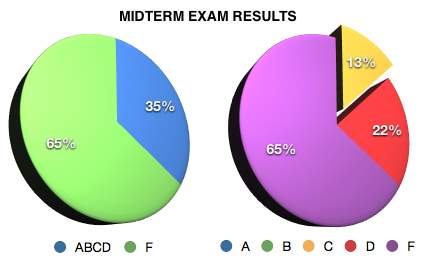| MIDTERM
EXAMINATION - ITEM ANALYSIS |
| TOPIC COVERAGE |
CHAPTERS 1-4 |
| SLOs ASSESSED |
COURSE-LEVEL SLOs for
CHAPTERS #1, 2, 3, and 4 |
| DATE GIVEN |
FEBRUARY 26, 2010 |
| TYPE OF EXAM |
THEORY QUESTIONS AND
PROBLEM
SOLVING |
| NUMBER OF ITEMS (QUESTIONS) |
30
MULTIPLE CHOICE ITEMS, 13 COMPLETION-TYPE QUESTIONS (SOME QUESTIONS
REQUIRE SUPPORTING COMPUTATIONS OR THE PREPARATION OF APPROPRIATE
FINANCIAL SCHEDULES) |
| NUMBER OF STUDENTS WHO TOOK
THE EXAM |
23 OF 27; 1 STUDENT
WITHDRAWN, 3 STUDENTS ABSENT
(NOT INCLUDED IN COUNT) |
| AVERAGE GRADE = 53%
LOWEST GRADE = 26% HIGHEST GRADE = 79% |
| ITEM
# |
ANSWERED
CORRECTLY |
PERCENT |
ITEM
# |
ANSWERED
CORRECTLY |
PERCENT |
| MULTIPLE
CHOICE WITH EMBEDDED PRETEST QUESTIONS (CHAPTERS 1-4) |
COMPLETION
TYPE-QUESTIONS (CHAPTER 3) |
| 1 |
6 |
32%Tests
the student's understanding of the differences between financial
accounting and management accounting
(Chapter 1 Course-Level SLO)
|
1
|
9 |
47%Tests
the student's understanding of organizational cost flows in a
manufacturing firm and his/her ability to identify the type of
transaction involved.
(Chapter 3 Course-Level SLO)
|
| 2 |
19 |
100% |
2 |
7 |
37%Tests
the student's understanding of organizational cost flows in a
manufacturing firm and his/her ability to identify the type of
transaction involved.
(Chapter 3 Course-Level SLO)
|
| 3 |
19 |
100% |
3 |
9 |
47%Tests
the student's understanding of organizational cost flows in a
manufacturing firm and his/her ability to journalize transactions
involving raw material and work in process inventories.
(Chapter 3 Course-Level SLO) |
| 4 |
18 |
95% |
4 |
3 |
16%Tests
the student's understanding of organizational cost flows in a
manufacturing firm and his/her ability to identify the type of
transaction involved with each flow cost.
(Chapter 3 Course-Level SLO)
|
| 5 |
17 |
89% |
5 |
9 |
47%Tests
the student's understanding of organizational cost flows in a
manufacturing firm and his/her ability to journalize transactions
involving work in process and finished goods inventories.
(Chapter 3 Course-Level SLO)
|
| 6 |
8 |
42%Tests
the student's understanding of organizational cost flows in a
manufacturing firm and his/her ability to give the appropriate journal
entry when goods are sold.
(Chapter 3 Course-Level SLO)
|
6 |
8 |
42%Tests
the student's understanding of organizational cost flows in a
manufacturing firm and his/her ability to identify the type of costs
involved in a given transaction. (Chapter 3 Course-Level SLO) |
| 7 |
14 |
74% |
7 |
16 |
84%
|
| 8 |
7 |
37%Requires
the student to identify which organizational characteristics critically
affect the design of a cost management system.
(Chapter 2 Course-Level SLO)
|
8 |
11 |
58% |
| 9 |
18 |
95% |
9 |
13 |
68% |
| 10 |
11 |
58% |
10 |
6 |
32%Tests
the student's ability to calculate product costs
(Chapter 3 Course-Level SLO)
|
| 11 |
6 |
32%Tests
the student's understanding of the degree of conversion taking place in
companies engaged in manufacturing and service operations.
(Chapter 3 Course-Level SLO)
|
11 |
3 |
16%Tests
the student's ability to identify period costs
(Chapter 3 Course-Level SLO)
|
| 12 |
13 |
65% |
12 |
16 |
84%
|
| 13 |
14 |
73% |
13 |
18 |
95% |
| 14 |
19 |
100% |
Tests
the student's knowledge and skill in completing a properly-formatted
work sheet
(Course-Level SLO #4)
REMARKS
OF THE TWENTY-THREE STUDENTS who took the test, fifteen
(65%)
failed. Only three (13%) passed with grade of C, while the remaining
five
(22%) barely made it with grade of D. (See
charts below.)
While the multiple choice questions (owing to their
highly conceptual nature) have
historically been
more challenging for many students even in past semesters, completion
questions included in this test
were easy. Some students, however, seemed to have difficulty
in understanding the questions. For example,
in
the statement "Raw Materials Inventory account is debited when
_________________," instead of giving the type of transaction
required to complete this sentence, the student gave the account title to be
credited to complete the related journal entry.
|
| 15 |
15 |
79% |
| 16 |
16 |
84% |
| 17 |
13 |
68%
|
| 18 |
16 |
84%
|
| 19 |
6 |
32%Requires
the student to identify ways by which activity-based costing and
activity-based management can effectively help managers.
(Chapter 4 Course-Level SLO)
|
| 20 |
8 |
42%Tests
the student's ability to identify which factor is most likely to make
the implementation of actity-based costing/activity-based management
slow and difficult. (Chapter 4 Course-Level SLO) |
| 21 |
11 |
58% |
| 22 |
16 |
84% |
| 23 |
17 |
89% |
| 24 |
13 |
68% |
| 25 |
10 |
53% |
| 26 |
7 |
37%Tests
the student's understanding of a traditional accounting system as
opposed to an activity-based accounting system.
(Chapter 4 Course-Level SLO)
|
| 27 |
10 |
53% |
| 28 |
6 |
32%Tests
the student's knowledge as to how preliminary costs allocations are
assigned under activity based costing.
(Chapter 4 Course-Level SLO)
|
| 29 |
4 |
21%Tests
the student's ability to point out the best reason for using
activity-based costing.
(Chapter 4 Course-Level SLO)
|
| 30 |
2 |
11%Tests
the student's understanding of cost-benefit analysis as a key concept
underlying cost driver analysis.
(Chapter 4 Course-Level SLO)
|

